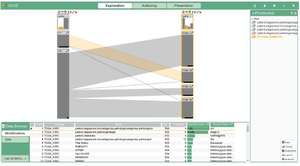Information
- Publication Type: Master Thesis
- Workgroup(s)/Project(s):
- Date: August 2018
- Date (Start): 3. January 2018
- Date (End): 18. August 2018
- Open Access: yes
- First Supervisor: Eduard Gröller
Abstract
Seeking relationships in multi-dimensional datasets is a common task, but can quickly become tedious due to the heterogeneity and increasing size of the data. Its visualization can be approached in a variety of ways: (i) projection techniques decrease the number of dimensions to a fraction before visualizing items, creating clusters where similarities in the high-level space may be derived; (ii) overview visualization techniques display selected attributes and all of their items’ values to discover patterns and find relationships; (iii) tabular techniques give an insight into the individual items and thus favor their detailed analysis and exploration. However, while the interactive selection of a data subset during exploration is most easily done with tabular visualizations, finding relationships and patterns is not. Also, with overview techniques the number of attribute combinations quickly outgrows reasonable dimensions. In this thesis, a data-driven touring process for Visual Analytics (VA) tools is presented that guides users in discovering relationships for a data subset of their interest. Based on the user’s selection, attributes that show some kind of similarity are presented. The selection can be done on attribute and item level. While a selected attribute is compared to all other attributes in the dataset, item sets are compared to the individual categories of attributes. This comparison can be based on a number of similarity measures. To cope with heterogeneity of data types, numerical attributes are discretized to achieve maximum similarity. In hierarchical attributes, the most similar subtree is sought. The touring process is also independent of the data domain and its visualization. This independence is demonstrated by the use of three different datasets and the integration of the touring process into two VA systems. These extended systems were shown to medical experts of the Kepler University Hospital, who will use them in the near future. Their feedback was incorporated to improve the guidance process.Additional Files and Images
Weblinks
No further information available.BibTeX
@mastersthesis{Eckelt_2018_01,
title = "Data-Driven User Guidance in Multi-Attribute Data
Exploration",
author = "Klaus Eckelt",
year = "2018",
abstract = "Seeking relationships in multi-dimensional datasets is a
common task, but can quickly become tedious due to the
heterogeneity and increasing size of the data. Its
visualization can be approached in a variety of ways: (i)
projection techniques decrease the number of dimensions to a
fraction before visualizing items, creating clusters where
similarities in the high-level space may be derived; (ii)
overview visualization techniques display selected
attributes and all of their items’ values to discover
patterns and find relationships; (iii) tabular techniques
give an insight into the individual items and thus favor
their detailed analysis and exploration. However, while the
interactive selection of a data subset during exploration is
most easily done with tabular visualizations, finding
relationships and patterns is not. Also, with overview
techniques the number of attribute combinations quickly
outgrows reasonable dimensions. In this thesis, a
data-driven touring process for Visual Analytics (VA) tools
is presented that guides users in discovering relationships
for a data subset of their interest. Based on the user’s
selection, attributes that show some kind of similarity are
presented. The selection can be done on attribute and item
level. While a selected attribute is compared to all other
attributes in the dataset, item sets are compared to the
individual categories of attributes. This comparison can be
based on a number of similarity measures. To cope with
heterogeneity of data types, numerical attributes are
discretized to achieve maximum similarity. In hierarchical
attributes, the most similar subtree is sought. The touring
process is also independent of the data domain and its
visualization. This independence is demonstrated by the use
of three different datasets and the integration of the
touring process into two VA systems. These extended systems
were shown to medical experts of the Kepler University
Hospital, who will use them in the near future. Their
feedback was incorporated to improve the guidance process.",
month = aug,
address = "Favoritenstrasse 9-11/E193-02, A-1040 Vienna, Austria",
school = "Institute of Computer Graphics and Algorithms, Vienna
University of Technology ",
URL = "https://www.cg.tuwien.ac.at/research/publications/2018/Eckelt_2018_01/",
}

 image
image Poster
Poster


